Unreal Engine 5 Simplified Mass Entity Query API Quickstart
Introduction
Unreal Engine 5 (UE5) features an entity component system (ECS) for high efficiency batch processing called Mass Entity. Epic developed a simplified Mass Entity API but I feel the documentation is sparse.
This post provides a full example to show its use.
The code for this example can be found here.
If you’re new to Mass Entity, check out these resources first:
- MassEntity Overview
- Your First 60 Minutes with Mass
- Large Numbers of Entities with Mass in UE5 (YouTube)
Example Overview
In this example we’ll:
- Create entities with a transform fragment and a shared const velocity fragment
- Make a processor to manipulate our entities using the simplified API
- Define an actor to spawn entities
- Run a level with our entities and view them in the Mass debugger.
Required setup
Add the MassGameplay plugin to your project’s .uproject file.
{
"Name": "MassGameplay",
"Enabled": true
}Add MassEntity and MassCommon to your .Build.cs file.
PublicDependencyModuleNames.AddRange(new string[] {
"Core", "CoreUObject", "Engine", "InputCore", "EnhancedInput",
"MassEntity", "MassCommon"
});Fragment Setup
Our entity data is stored in Mass fragments which are just normal C++ structs.
Include these headers.
#include "CoreMinimal.h"
#include "MassEntityTypes.h"
#include "MassFragments.generated.h"Define the transform fragment inheriting from FMassFragment.
USTRUCT()
struct FMassTransformFragment : public FMassFragment {
GENERATED_BODY()
FMassTransformFragment() = default;
FMassTransformFragment(FTransform Transform)
: Transform(Transform) {}
UPROPERTY()
FTransform Transform{};
};Define the velocity fragment inheriting from FMassConstSharedFragment.
USTRUCT()
struct FMassVelocityConstSharedFragment : public FMassConstSharedFragment {
GENERATED_BODY()
FMassVelocityConstSharedFragment() = default;
FMassVelocityConstSharedFragment(FVector Velocity)
: Velocity(Velocity) {}
UPROPERTY()
FVector Velocity{FVector::ZeroVector};
};Now we need to implement our fragment processing.
With the simplified Mass Entity API, processing is performed in a struct inheriting from UE::Mass::FQueryExecutor which is wrapped in a UMassProcessor class.
In this example, the query and wrapper will coexist in the same file: MassVelocityProcessor.(h/cpp).
Query Design
Header File
Add these includes:
#include "CoreMinimal.h"
#include "MassProcessor.h"
#include "MassQueryExecutor.h"
#include "MassFragments.h"
#include "MassVelocityProcessor.generated.h"The query class:
struct FMassVelocityExecutor : public UE::Mass::FQueryExecutor {
FMassVelocityExecutor() = default;
// Define which fragments we need and how we access them
using Query = UE::Mass::FQueryDefinition<
UE::Mass::FMutableFragmentAccess<FMassTransformFragment>,
UE::Mass::FConstSharedFragmentAccess<FMassVelocityConstSharedFragment>>;
Query Accessors{*this};
virtual void Execute(FMassExecutionContext& Context) override;
};Query’s template parameters specify the required data and its access modes.
We need mutable access to FMassTransformFragment and access to the const shared FMassVelocityConstSharedFragment.
Execute performs the fragment processing.
Source File
Add the following include:
#include "MassExecutionContext.h"The execution function:
void FMassVelocityExecutor::Execute(FMassExecutionContext& Context) {
constexpr auto Executor{[](FMassExecutionContext& context, Query& query) {
auto const N{context.GetNumEntities()};
auto const DeltaTime{context.GetDeltaTimeSeconds()};
auto const Transforms{context.GetMutableFragmentView<FMassTransformFragment>()};
auto const& Velocity{context.GetConstSharedFragment<FMassVelocityConstSharedFragment>()};
auto const displacement{Velocity.Velocity * DeltaTime};
for (int32 i{0}; i < N; ++i) {
Transforms[i].Transform.AddToTranslation(displacement);
}
}};
ForEachEntityChunk(Context, Accessors, std::move(Executor));
}The processing is carried out in a lambda which is passed to ForEachEntityChunk.
Chunks are groups of entities that are processed in bulk by a single lambda call.
The following ForEach functions are available:
ForEachEntityForEachEntityChunkParallelForEachEntityParallelForEachEntityChunk
The non-Chunk functions can introduce a large overhead as the GetFragment functions must be called once per entity instead of just once per chunk.
The parallel versions distribute the processing over multiple threads.
Our lambda accesses the entities passed to it by ForEachEntityChunk and updates the fragment’s transform based on the velocity and delta time.
Processor
The processor just wraps the Query class into the main UMassProcessor type used by Mass Entity.
Header File
It contains a constructor and member variables for the query.
UCLASS()
class MASS_SIMPLIFIED_API_API UMassVelocityProcessor : public UMassProcessor {
GENERATED_BODY()
public:
UMassVelocityProcessor();
private:
FMassEntityQuery EntityQuery;
TSharedPtr<FMassVelocityExecutor> Executor;
};Note: The macro MASS_SIMPLIFIED_API_API comes from Unreal’s use of <module>_API and I named the project mass_simplified_api.
Source File
Add the following include for the ProcessorGroupNames to be used later.
#include "MassCommonTypes.h"Implement the constructor like so:
UMassVelocityProcessor::UMassVelocityProcessor()
: EntityQuery(*this)
, Executor(UE::Mass::FQueryExecutor::CreateQuery<FMassVelocityExecutor>(EntityQuery, this)) {
AutoExecuteQuery = Executor;
ExecutionOrder.ExecuteInGroup = UE::Mass::ProcessorGroupNames::Movement;
SetProcessingPhase(EMassProcessingPhase::PrePhysics);
ExecutionFlags = static_cast<int32>(EProcessorExecutionFlags::AllWorldModes);
bAutoRegisterWithProcessingPhases = true;
}You must initialise EntityQuery with *this or it won’t be registered with the processor and thus won’t run.
Create the executor object to process the fragments.
AutoExecuteQueryshould be self-explanatoryExecutionOrdertells Mass when to run the processor relative to other processors- The Processing Phase is Mass’s version of tick groups which denote what part of the frame the processor runs in
ExecutionFlagssay what game context the Processor should run inbAutoRegisterWithProcessingPhasestells the system to automatically register our processor with the Mass system
Spawner Actor
We’ll make a simple actor to spawn our entities. It defines an entity archetype and spawns an entity each tick.
Batch spawning is more efficient but I want to keep things simple here.
For reference, batch spawning is performed using FMassEntityManager::BatchCreateEntities (potentially with FMassEntityManager::BatchReserveEntities to pre-allocate entities if many are expected).
Header File
Add these includes.
#include "CoreMinimal.h"
#include "GameFramework/Actor.h"
#include "MassArchetypeTypes.h"
#include "MassEntityTypes.h"
#include "MassEntitySpawner.generated.h"Create a forward declaration for the Mass Entity subsystem.
class UMassEntitySubsystem;Our class consists of entity information variables and member functions to define and spawn entities.
UCLASS()
class AMassEntitySpawner : public AActor {
GENERATED_BODY()
public:
AMassEntitySpawner();
// Shared velocity for all spawned entities
UPROPERTY(EditAnywhere, BlueprintReadWrite, Category = "Mass Entity")
FVector EntityVelocity{100.0f, 0.0f, 0.0f};
protected:
virtual void BeginPlay() override;
virtual void Tick(float DeltaTime) override;
private:
void CreateArchetype(UMassEntitySubsystem& MassEntitySubsystem,
FMassEntityManager& EntityManager);
void CreateSharedValues(FMassEntityManager& EntityManager);
void SpawnEntity(UMassEntitySubsystem& MassEntitySubsystem, FMassEntityManager& EntityManager);
FMassArchetypeHandle Archetype{};
FMassArchetypeSharedFragmentValues SharedValues{};
};Source File
Add the following includes.
#include "MassEntitySpawner.h"
#include "MassArchetypeTypes.h"
#include "MassEntitySubsystem.h"
#include "MassFragments.h"In the constructor I set the ticking to 20 Hz to reduce the number of entities spawned per second.
AMassEntitySpawner::AMassEntitySpawner() {
PrimaryActorTick.bCanEverTick = true;
PrimaryActorTick.TickInterval = 0.05f;
}In BeginPlay, create our archetype and its shared values.
void AMassEntitySpawner::BeginPlay() {
Super::BeginPlay();
auto MassEntitySubsystem{GetWorld()->GetSubsystem<UMassEntitySubsystem>()};
if (!MassEntitySubsystem) {
UE_LOG(LogTemp, Error, TEXT("MassEntitySubsystem not found!"));
return;
}
auto& EntityManager{MassEntitySubsystem->GetMutableEntityManager()};
CreateArchetype(*MassEntitySubsystem, EntityManager);
CreateSharedValues(EntityManager);
}Archetypes are created with EntityManager::CreateArchetype.
Specify the required data in FMassArchetypeCompositionDescriptor and some additional data such as the debug name in FMassArchetypeCreationParams.
void AMassEntitySpawner::CreateArchetype(UMassEntitySubsystem& MassEntitySubsystem,
FMassEntityManager& EntityManager) {
auto Descriptor{FMassArchetypeCompositionDescriptor{}};
Descriptor.Fragments.Add(*FMassTransformFragment::StaticStruct());
Descriptor.ConstSharedFragments.Add(*FMassVelocityConstSharedFragment::StaticStruct());
auto CreationParams{FMassArchetypeCreationParams{}};
CreationParams.DebugName = FName(TEXT("ExampleArchetype"));
Archetype = EntityManager.CreateArchetype(Descriptor, CreationParams);
}CreateSharedValues adds the shared fragment data to our SharedValues data.
The EntityManager caches the shared values so subsequent calls just return a handle to the existing value.
The shared fragments need to be sorted relative to their definition in the Archetype so be sure to call .Sort() after creating them.
void AMassEntitySpawner::CreateSharedValues(FMassEntityManager& EntityManager) {
auto const VelocityHandle{
EntityManager.GetOrCreateConstSharedFragment<FMassVelocityConstSharedFragment>(
EntityVelocity)};
SharedValues.Add(VelocityHandle);
SharedValues.Sort();
}Within the tick we just call SpawnEntity.
void AMassEntitySpawner::Tick(float DeltaTime) {
Super::Tick(DeltaTime);
auto MassEntitySubsystem{GetWorld()->GetSubsystem<UMassEntitySubsystem>()};
if (!MassEntitySubsystem) {
UE_LOG(LogTemp, Error, TEXT("MassEntitySubsystem not found!"));
return;
}
auto& EntityManager{MassEntitySubsystem->GetMutableEntityManager()};
SpawnEntity(*MassEntitySubsystem, EntityManager);
}SpawnEntity creates a new entity handle using EntityManager.CreateEntity and configures the initial transform.
void AMassEntitySpawner::SpawnEntity(UMassEntitySubsystem& MassEntitySubsystem,
FMassEntityManager& EntityManager) {
FMassEntityHandle EntityHandle{EntityManager.CreateEntity(Archetype, SharedValues)};
{
auto& TransformFragment{
EntityManager.GetFragmentDataChecked<FMassTransformFragment>(EntityHandle)};
TransformFragment.Transform = GetActorTransform();
}
}Simulation
Now we’ll use our entity spawner and view the fragment data in the Mass debugger (see overview).
Load the Unreal editor and create an instance of AMassEntitySpawner.
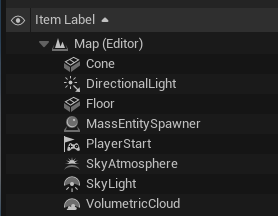
Run the game and load the Mass debugger.

In the top right of the debugger window, set the environment to our active level.

You should be able to see the processor in the processor list.
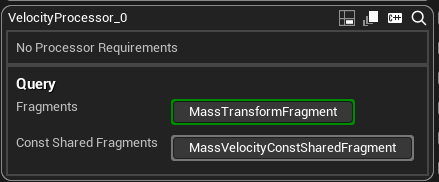
You should also see the archetype and the number of entities.
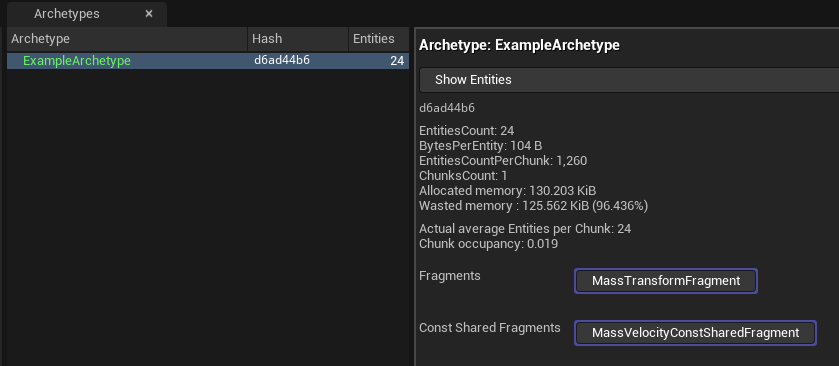
Use the Select Fragments dropdown box and check all the fragments.
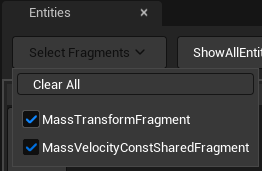
You should now see the fragments and their values.
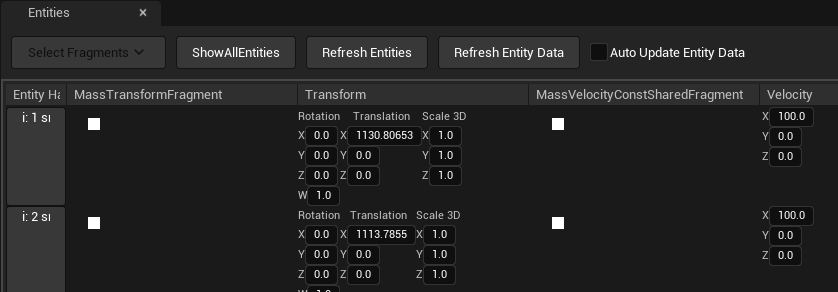
Conclusion
This article has shown how to use the simplified Mass Entity API. In summary:
- Define fragment structs
- Create a query executor inheriting from
UE::Mass::FQueryExecutor - Wrap the executor in a
UMassProcessor - Define an archetype using
FMassEntityManager::CreateArchetype - Spawn entities using
FMassEntityManager::CreateEntity